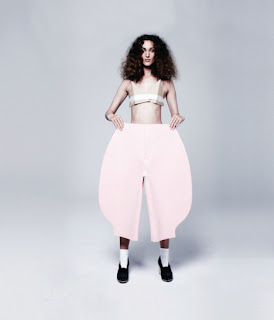To me, fashion falls into one of two categories. It can be instantly appealing and you would like to wear it; or it is something you wouldn't necessarily wear but it is driving fashion forward. --Grace Coddington in Grace: A Memoir (327)
Comme des Garçons is unlike most other high-end fashion labels, with clothes more akin to stylized sculpture than fashion. The brand's aesthetic definitely falls into Grace's second category of fashion, where you wouldn't necessarily wear the clothes, but they nonetheless drive fashion forward.
Japanese designer Rei Kawakubo's clothes are based on concepts, not utility. Since its founding in 1969, Comme des Garçons has sought to represent the woman "who is not swayed by what her husband thinks" (Kawakubo quoted in Voguepedia). Her early pieces eschew symmetry and look destroyed or deconstructed--imagine three-armed jackets and face-shielding turtlenecks (Nymag.com).
Fashion buffs often cite Kawakubo's spring 1997 Paris show as classic Comme des Garçons. The show, infamously known as the "lump and bumps" or "tumours" collection, caused a furor in the fashion community when she sent models down the runway wearing outrageously bulgy outfits.
Comme des Garçons' daring is also demonstrated in the spring 2000 collection, where she showed garments that looked like the paper patterns of clothes rather than the actual cloth clothes themselves. In everything Kawakubo does, she challenges consumers and, by extension, consumerist culture.
Even the first Comme des Garçons fragrance, Odeur 53, isn't obviously saleable. Launched in 1998, this "anti-perfume" is a unisex fragrance with 53 different notes, such as nail polish and burnt rubber (Voguepedia).
Kawakubo's stores aren't inviting either. In 2004, for example, Comme des Garçons began to roll out a series of guerrilla pop-up shops in offbeat locations away from traditional fashion capitals. The interior of the shop in Basil, Switzerland, is just racks of clothes set in an old factory with cement flooring and nothing else, not even a chair to sit on (see below).

Because Comme des Garçons is irreverent, too, the label doesn't hesitate to mix "high" and "low" fashion. Kawakubo was invited and accepted the task to produce a guest collection for H&M in 2008. “What’s interesting about collaborations," she says, "is the possibility for one plus one to equal three." Selling to the middle- to low-income bracket is not a dilution of the brand: it's a creative opportunity.
My favourite Kawakubo show, in fact, is the one where she created beautiful, intellectually provocative clothes out of recycled fabrics, a challenge to high/low as well as old/new.
 |
| Rei Kawakubo |
Fashion buffs often cite Kawakubo's spring 1997 Paris show as classic Comme des Garçons. The show, infamously known as the "lump and bumps" or "tumours" collection, caused a furor in the fashion community when she sent models down the runway wearing outrageously bulgy outfits.
 |
| The "tumours" collection |
Comme des Garçons' daring is also demonstrated in the spring 2000 collection, where she showed garments that looked like the paper patterns of clothes rather than the actual cloth clothes themselves. In everything Kawakubo does, she challenges consumers and, by extension, consumerist culture.
 |
| Paper doll clothes, anyone? |
 |
| Odeur 53 fragrance |
Kawakubo's stores aren't inviting either. In 2004, for example, Comme des Garçons began to roll out a series of guerrilla pop-up shops in offbeat locations away from traditional fashion capitals. The interior of the shop in Basil, Switzerland, is just racks of clothes set in an old factory with cement flooring and nothing else, not even a chair to sit on (see below).

Because Comme des Garçons is irreverent, too, the label doesn't hesitate to mix "high" and "low" fashion. Kawakubo was invited and accepted the task to produce a guest collection for H&M in 2008. “What’s interesting about collaborations," she says, "is the possibility for one plus one to equal three." Selling to the middle- to low-income bracket is not a dilution of the brand: it's a creative opportunity.
 |
| For H&M |
 |
| Clothes made out of recycled fabrics. |
Although, as some observers contend, Kawakubo's designs have become less rebellious over the years due to her use of so-called traditional patterns and materials, such as gold- and silver-flecked tweed and floral motifs, her work still manages to conflate fashion and art.
Whatever the final verdict on Kawakubo's later work, Voguepedia authors say Comme des Garçons' influence on the history of fashion is equal to that of Balenciaga or Chanel. The ideas behind her work transform fashion into an irony-laden post-modern art form; Kawakubo challenges the idea of wearable, consumable fashion yet owns a $180 million business. She's the Salvador Dalí of clothes designers.
 |
| For Vogue, September 2007 |
 |
| Fall 2009 collection |
 |
| An assemblage of past Comme des Garçons shows |

No comments:
Post a Comment